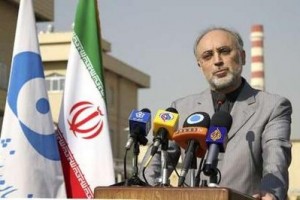 Iran claimed another advance in its disputed nuclear activities on Sunday, a day before opening a new round of talks on that work with world powers.
Iran claimed another advance in its disputed nuclear activities on Sunday, a day before opening a new round of talks on that work with world powers.
The country’s nuclear chief said that for the first time the country had mined its own uranium — which can be processed into material used to make nuclear energy or nuclear weapons — giving it a way to bypass U.N. sanctions prohibiting the material’s import.
The announcement displays Iran’s determination to master nuclear technology without outside help just a day before world powers meet Iranian officials in Geneva in another attempt to persuade them to freeze key aspects of that work.
Nuclear chief Ali Akbar Salehi said the uranium ore concentrate, known as yellowcake, was produced at the Gachin uranium mine in southern Iran and delivered to the uranium conversion facility in the central city of Isfahan for reprocessing.
Salehi, head of the Atomic Energy Organization of Iran, said the delivery was evidence that last week’s assassination of a top Iranian nuclear scientist and the wounding of another in mysterious bombings will not hamper Iran’s nuclear progress.
“Today, we witnessed the shipment of the first domestically produced yellowcake … from Gachin mine to the Isfahan nuclear facility,” said Salehi, whose comments were broadcast live on state television.
Iran is under four sets of U.N. Security Council sanctions that forbid the supply of nuclear materials to Tehran.
In 2009, Western nations claimed Iran was running out of raw uranium for its nuclear program. Tehran issued denials but, whatever the truth, has in recent years sought to extract uranium from its own deposits.
Iran acquired a considerable stock of yellowcake from South Africa in the 1970s under the former U.S.-backed shah’s original nuclear program, as well as unspecified quantities of yellowcake obtained from China long before the U.N. sanctions.
Salehi, who is also the country’s vice president, said the step meant Iran was now self-sufficient over the entire nuclear fuel cycle — from extracting uranium ore to enriching it and producing nuclear fuel.
He added that the message to those meeting with Iran in Geneva on Monday and Tuesday was that they cannot stop Iran’s nuclear work.
“No matter how much effort they put into their sanctions … our nuclear activities will proceed and they will witness greater achievements in the future,” he said in an interview with state-run Press TV after the announcement.
Salehi said the activity will be carried out under the supervision of the U.N. nuclear watchdog, the International Atomic Energy Agency.
Iran’s nuclear chief said a bigger uranium mine at Saghand, in central Iran, will be inaugurated “in the not too distant future.”
The Gachin uranium mill near Bandar Abbas processes ore extracted from a nearby mine into yellowcake. The processing is part of the early stages before actual enrichment of uranium.
Yellowcake is then taken to the Isfahan facility to be processed into uranium hexaflouride, which later can be turned into a gas used as feedstock for enriching uranium.
Uranium enriched to low grades is used for fuel in nuclear reactors, but further enrichment makes it suitable for atomic bombs.
The United States and some of its allies accuse Iran of using its civil nuclear program as a cover to develop nuclear weapons. Iran has denied the accusation, saying its nuclear program is geared solely toward generating electricity and producing medical isotope to treat patients.
Salehi did not provide details on how much yellowcake had been transferred to Isfahan, but said the shipments, for now, would be carried out “continuously.” State TV showed a large, covered truck carrying the yellowcake.
In October, Salehi said nuclear experts have discovered larger uranium reserves than previously thought at Gachin and were stepping up exploration of the ore.
The Iranian government has also provided funds to its nuclear agency to begin ore extraction at Saghand, the mine with the largest uranium reserves in the country. Saghand has not yet become operational.
Saghand’s known reserves are estimated at more than 1.7 million tons of medium quality ore. The mine, about 300 miles (480 kilometers) south of Tehran, has a production capacity of 132,000 tons of uranium ore per year. It consists of an open pit with minimal reserves and a deep mine nearby. A lack of funds has reportedly delayed ore extraction at the mine.
Iran announced discoveries of new uranium deposits in 2006 at three sites in the central areas of Khoshoomi, Charchooleh and Narigan. AP

Leave a Reply
You must be logged in to post a comment.